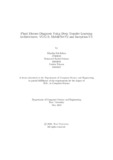Plant disease diagnosis using deep transfer learning architectures- VGG19, MobileNetV2 and Inception-V3
Abstract
The importance of a tree’s involvement in human life and the environment cannot
be overstated. Plants, like humans and animals, are susceptible to disease.
Many vegetation diseases might impair a plant’s healthy development. For accurate
identification and treatment of plant pathogens, precise detection of those chronic
conditions is essential. This paper represents 3 deep learning approaches to distinguish
and classify plant diseases by analyzing the leaf of a given plant. We worked
on late leaf curl, leaf spot, mosaic virus, black rot, powdery mildew, common rust,
bacterial spot, leaf scorch, syndromes of late and early blight of crops similar to
corn, potato, tomato, squash, pepper, cherry, grape, orange, strawberry, apple etc.
The proposed strategy improves disease identification and classification of deformed
collected leaves. The model performs its function by categorizing images into two
groups, diseased and healthy. Moreover, deep learning architectures are made up
of several processing layers that learn the data visualizations with discrete levels
of abstraction. Collecting data sets is one of the most crucial steps to creating any
recognition system. Labeling an image means pinpointing the subject we will be trying
to find, Training the algorithms through those images to detect the subjects is
critical in detecting diseases. In this research paper, to detect diseases from images,
firstly, we collected data sets containing more than 87,123 images of plant diseases.
After that, we labeled those images in 38 labels and we used VGG19 model on those
images to train the model to detect diseases from the images given to it, afterwards
two deep learning models MobileNetV2 and Inception-v3 was used to detect diseases
which provided us with 94.21%, 97.93% and 98.52% accuracy respectively. In short,
we’re using three deep learning models and comparing the accuracy rate on a huge
data set with 38 classes which will help the masses to detect abnormalities in plants.
It will also help the harvesters related to the agricultural works find the contagion
in their cultivated crops further to develop our horticulture sector and our farmers’
situation.

